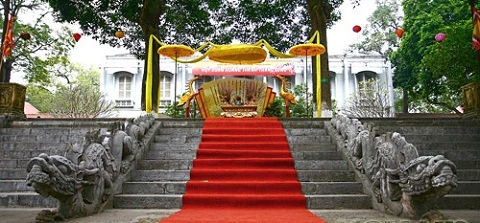Hanoi (VNA) - The excavation of Kinh Thien Palace in 2016 continues to demonstrate the variety and complexity of the relics within the main area of the palace, as well as contributes to clarifying the enormous values of Vietnam’s world heritage, Thang Long Royal Citadel.
The conclusion was made at a scientific conference entitled Reports on Preliminary Results of Kinh Thien Palace Excavation in 2016, jointly organised by Thang Long-Hanoi Heritage Preservation Centre and Vietnam Institute of Archaeology on December 28. The event drew the participation of many representative of Hanoi’s authority, representatives of relevant organisations and renowned scientists.
Taking place from January to December this year, the excavation was conducted by Thang Long-Hanoi Heritage Preservation Centre and Vietnam Institute of Archaeology on a total area of nearly 1,000 sq.m in the main area of Kinh Thien Palace.
According to Associate Professor Tong Trung Tin, successive cultural layers of approximately 4-metre depth that expanded in over ten centuries, from the 8th-9th century to 19th-20th century, have been clarified.
Continuing the results of the excavations in 2012, 2013, 2014 and 2015, the excavation of this year has also clarified the architecture southwest of the main area of Kinh Thien Palace, including the general court, surrounding walls, corridor that dated back to the later Le Dynasty early period and later Le Dynasty warlord period in the 15th to 18th century.
Especially, a part of the architectural space of the Ly Dynasty (1009-1225) and more pillar foundations have been unearthed.
“The highlight of the excavation is the vestiges of the large-scale water systems, contributing to the study of Ly Dynasty’s planning in the centre of the royal city,” Tin says.
According to professor Phan Huy Le, chairman of Vietnam Association of History and Science, the results have painted a clearer picture of Kinh Thien Palace’s space.
“The later Le Dynasty warlord period has proved to have been prosperous, especially in the 17th century. Besides, proof of international trade is the new foundation of this excavation that influenced the whole context of the country at that time. At the same time, the minimum scale of ancient Dai La Citadel has been made clear,” Le says.
The professor also suggests new targets for the excavation in the area for the upcoming years, including digitising the relics to compile scientific dossiers, connecting the results of the excavations and regularly promoting the values of Thang Long Royal Citadel so that more visitors can learn about Vietnam’s world heritage.
The excavated area will be open for public visit this upcoming Lunar New Year.
Kinh Thien Palace is the most important building in the Thang Long Royal citadel, which was recognised by UNESCO as a World Heritage Site in 2000. It sits in the centre of the complex, facing Doan Mon (south gate) and Flag Tower. -VNA
























